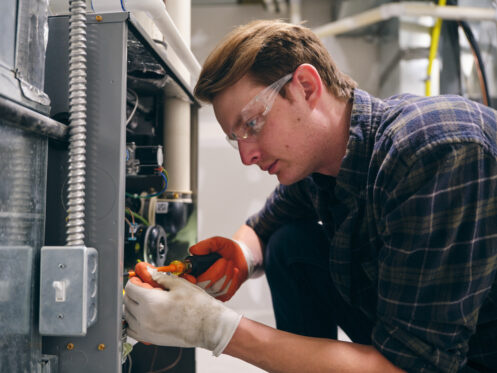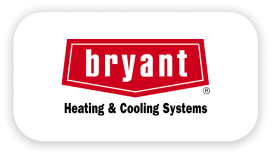Annual maintenance helps your heating system function effectively during the winter. These 14 checklist tasks can help you prepare your home’s furnace for the upcoming cold weather.
1. Replace the Air Filters
If you have yet to change the air filters in your furnace, you will want to complete this task before winter. Replacing the air filters every two to three months helps your system work more efficiently. They can also help prolong your furnace’s lifespan.
Clean air filters contribute to better air quality in your home. You should ensure you use high-quality air filters in your heater. You likewise must ensure they are the right size for it.
2. Lubricate Moving Parts
Your heater contains numerous moving parts that all play a key role in its safe function. These parts include belts, fan blades, inducer blades, pulleys and bearings.
Without proper lubrication, they can rub and grind against each other, creating friction and causing them to wear out. You can keep your home’s furnace running better and prepare it for cold weather by lubricating these parts before you turn your heat on for the winter.
3. Check the Thermostat
You need to ensure your heater’s thermostat operates reliably before the arrival of cold weather. To check the thermostat, you can set it to a higher temperature than the temperature of the air in your home. The furnace should kick on, and the thermostat should reach the set temperature.
You will also want to make sure it has the right date and time if you have a digital thermostat. You may find it more convenient to upgrade to an energy-efficient smart thermostat.
4. Inspect the Connections
Inspecting the connections plays a key role in maintaining your home’s furnace. To inspect them, you should first turn off the power to your furnace. You should then inspect and test the terminals and make sure all of the connections are tight and securely in place.
After you inspect the connections, you can turn the system back on. You will then want to make sure it operates normally. If you find loose or damaged connections or your furnace fails to turn back on, you need to hire an HVAC technician to service it.
5. Clean the Flame Sensor
You also need to turn off the furnace’s power to clean the flame sensor. This task requires loosening the hex head screw that holds the sensor in place.
You must then detach its wire before using a steel wool pad to remove debris from the metal part of the sensor. After you remove the debris, you can replace the sensor.
6. Check the Gas Pressure
Your checklist should include checking the gas pressure if your furnace runs on propane. Checking it calls for you to examine the meter box and gauge the current pressure.
If the pressure is too high, you should turn the propane knob in the clockwise direction to lower it. Alternatively, turn the knob counterclockwise to increase the pressure. An HVAC technician can handle this task to ensure you avoid damaging your furnace or compromising its efficiency.
7. Inspect the Gas Flue
You also need to check the gas flue to ready your system for cold weather. You should look for rust, water stains or debris on or under it.
You will also need to examine the joints for wear and tear, as well as ensure the brackets and support are holding the flue securely in place. This task mitigates the risk of a gas leak.
8. Clean the Vents
Cleaning the vents helps your furnace reach and maintain the set thermostat temperature. They also spare your system from overworking itself as it runs. This task requires cleaning off the grates with a soft brush and warm water.
For larger air return vents, you can use a vacuum hose or broom to remove dust and debris. This task should also include looking inside the vents to make sure they do not have clogs in them.
9. Seal the Ducts
As you ready for the system for cold weather, you will need to seal the ducts if they let in cold air. You should inspect them for damage like holes, cracks and tears.
You can seal them with caulk or high-quality tape to seal the ducts. Foil-face or mastic tape proves effective in sealing openings in and around ductwork.
10. Check the Pilot Light
You will also want to check the pilot light in your furnace to ready it for the winter. The pilot light should have a blue flame. If it has an orange or yellow flame, you need to hire a technician to serve your furnace.
An orange or yellow flame can indicate your pilot light is not getting enough oxygen. It can also mean the furnace’s air intake valve has a clog in it. An HVAC technician can inspect the valve and remove the clog in it.
11. Inspect the Condensate Drain-
The condensate drain prevents water from building up in your heating system. When it becomes clogged, it can cause your furnace to leak water.
Part of keeping this system operational involves inspecting and cleaning out the condensate drain. Debris like dirt and dust can clog it. Algae and mold can also grow in it and prevent water from draining properly. Cleaning it out at least once a year mitigates water leaks and water damage.
12. Listen for Unusual Noises
When you turn on your furnace, you should listen for it to make any unusual noises. Noises like rattling or squealing can signal that your system has a malfunction and needs immediate attention.
The solution could involve tightening a loose part or replacing a belt. It can also include lubricating parts to minimize grinding and squealing noises. A technician can find the sources of the unusual noises and repair the issues that cause them.
13. Inspect the Insulation
Your heating system operates more efficiently when you insulate your home. It also helps the system maintain the set thermostat temperature. If you find wet, missing or damaged insulation, especially around your ductwork, you should replace it before turning on your furnace for the winter.
14. Schedule Yearly Professional HVAC Maintenance
Professional HVAC maintenance plays a key role in your heating unit’s performance. The technician maintaining your system will inspect components like the heat exchanger and CO detector. This professional will also examine all of the wiring and connections to ensure your furnace can operate safely.
An annual tune-up mitigates the risk of your heating system breaking down and needing repairs in the middle of winter. It also helps your system last longer and can keep your utility bills more affordable. If you have a warranty on your furnace, you might keep it active by having a professional HVAC technician maintain it at least once a year.
Choose Us for Furnace Maintenance
Our team at Pro Heating and Cooling, Inc. treats our customers in the Hillsboro service area with respect and honesty. We never use bait-and-switch techniques when you hire us to service your home’s air conditioner, furnace or thermostat. You can trust us for fast and reliable service.
Our company employs NATE-certified, licensed and insured technicians. We also belong to the Air Conditioning Contractors of America and won NextDoor’s Neighborhood Fave award. We serve the area as an Energy Star provider and have EPA certification.
Our HVAC professionals can help you prepare your furnace for cold weather with our heating maintenance services. Contact us to learn more about our heating services!



